
24 minute read
EXCAVATOR IDENTIFICATION
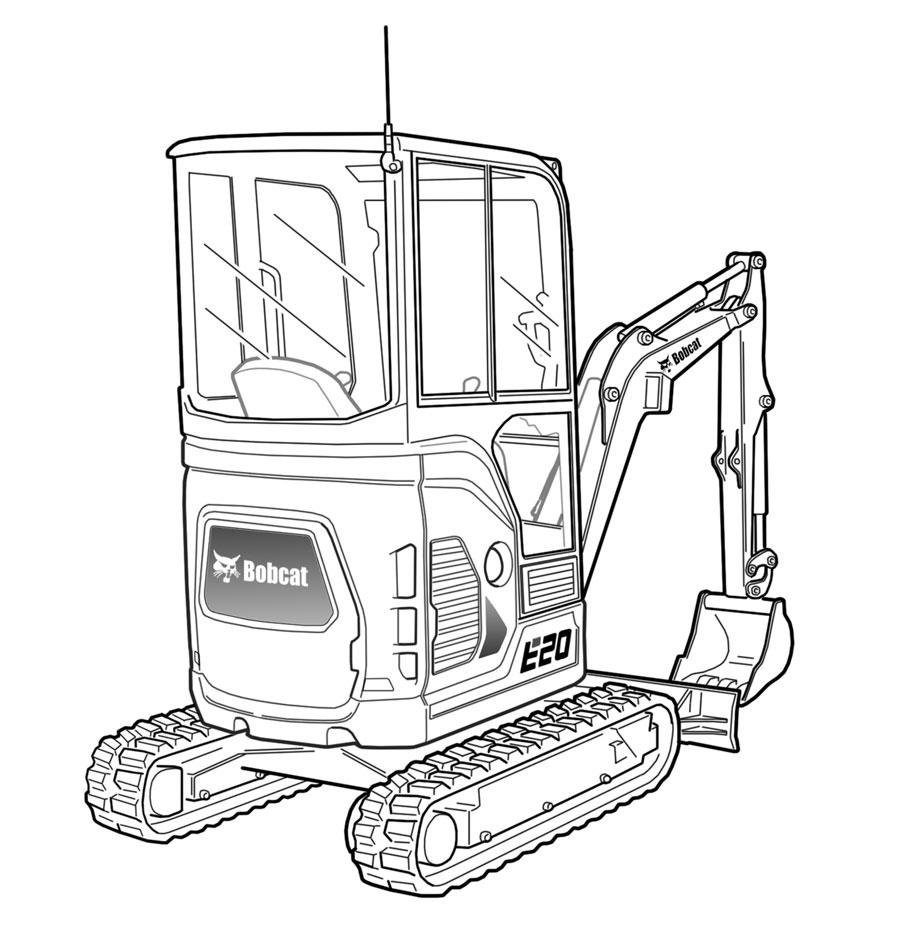
[A] BUCKET - Several different buckets and other attachments are available for the Bobcat excavator.
[B] ROPS, TOPS - (Roll-Over Protective Structure / Tip-Over Protective Structure) as standard equipment. The ROPS / TOPS meets ISO 12117-2 AND ISO 12117.
[C] ATTACMENT COUPLERS - Optional attachment couplers are available.
FEATURES, ACCESSORIES AND ATTACHMENTS
Standard Items
Model E20 Bobcat excavators are equipped with the following standard items:
• Canopy with ROPS / TOPS / ROPS Approval
• Rubber Tracks 230 mm (9.0 in)
• Dozer Blade 1354 mm (53.3 in) (Including extensions)
• Auxiliary Hydraulics On Boom (Double Acting)
• Hydraulic Joystick Controls
• Engine Speed Control Lever
• Hydraulic and Travel Control Lockouts
• Hydraulic Retractable Undercarriage (1360 mm to 980 mm)
• Track Retraction - Expansion Valve / Switch
• Two-Speed Travel
• Engine with Shut Down
• Work Light - Boom Mounted
• Horn
• Stationary Seat
• Retractable Seat Belt
• Spark Arrester Muffler
• Advanced Diagnostics
• Counterweight
• Battery Kill Switch
• Upperstructure with Four Point Tie Down
• Fuel Filter Sediment Bowl
Options And Accessories
Below is a list of some equipment available from your Bobcat excavator dealer as Dealer and / or Factory Installed Accessories and Factory Installed Options. See your Bobcat dealer for other available options, accessories and attachments.
• Auto Shift Drive Motors
• Auxiliary Hydraulics On Arm
• Enclosed Cab With Heater
• Travel Motion Alarm
• Keyless Start
• Canopy / Cab Mounted Lights
• Long Dozer Blade
• Long Arm
• Top Guard Kit (FOGS)
• Special Application Kit
• Attachment Quick Coupler (Klac)
• Attachment Quick Coupler, German Style Quick Coupler
• Object Handling Certified (boom / arm load holding valves, overload warning and lift eye)
• Load Holding Valve - Boom
• Load Holding Valve - Arm
• Lift Eye
• Adjustable Seat or Suspension Seat
• Strobe Light
• Side Mirror
• Fire Extinguisher
• Radio
• Demolition Kit
• Hose Air Bleed Kit
• Beacon
• Antenna and Speakers Kit
• Muffler Purifier Kit
• Offset Drain Line Kit
• Bonnet Reinforcement Kit
• Secondary Auxiliary Hydraulics
• Mechanical Pin Grabber Coupler
Specifications subject to change without notice and standard items can vary.
Attachments
These and other attachments are approved for use on this model Bobcat excavator. Do not use unapproved attachments. Attachments not manufactured by Bobcat can not be approved.
The versatile Bobcat excavator quickly turns into a multijob machine with a variety of attachments.
See your Bobcat dealer for information about approved attachments and attachment Operation & Maintenance Manuals.
•Auger
•Breaker
•Hydraulic Clamp
•Laser Receiver
•Reverse Coupler
•Tilt Bucket
•Flail Mower
Buckets Available
Increase the versatility of your Bobcat excavator with a variety of bucket sizes.
Many bucket styles, widths and different capacities are available for a variety of different applications. They include Trenching, Digging, Grading, Tilt, to name a few. See your Bobcat dealer for the correct bucket for your Bobcat excavator and application.
FEATURES, ACCESSORIES AND ATTACHMENTS (CONT’D)
Falling-Object Guards (FOGS)
Figure 4
Overhead Guard
Available for special applications that require protection from smaller objects that can fall on the canopy / cab or restrict material from entering canopy / cab openings [Figure 4] and [Figure 5].
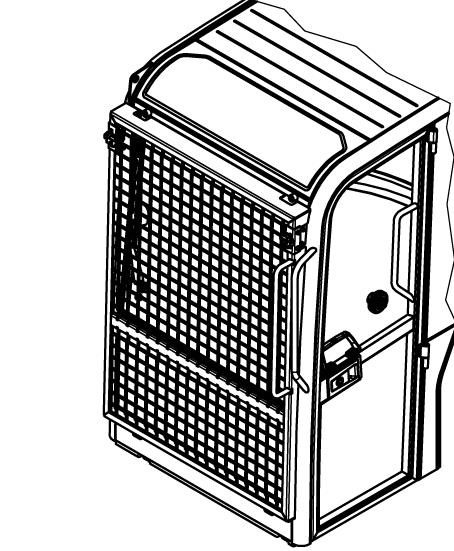
The excavator must have the overhead guard [Figure 4] installed to meet the top guard requirements in ISO 10262.
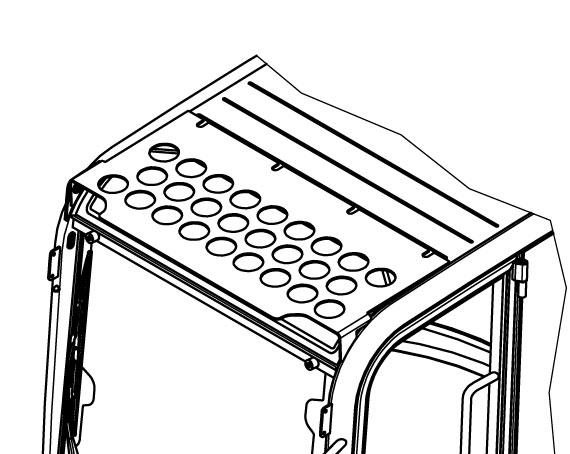
See your Bobcat Dealer for more information.
NOTE:The Falling-Object Guard is factory installed on the canopy.
Special Applications Kit
Figure 5
Special Application Kit
Available for special applications that require protection from objects entering the front of the excavator.
The excavator must have the special applications kit [Figure 5] installed to meet the front guard requirements in ISO 10262 - level 1.
Kit includes an upper and lower screen guard.
See your Bobcat Dealer for more information.
Special Applications Kit Inspection And Maintenance
The Special Applications Kit must be regularly inspected and maintained. Inspect the screen for damage. Replace parts as necessary.
SAFETY INSTRUCTIONS Before Operation
Carefully follow the operating and maintenance instructions in this manual.
The Bobcat excavator is highly manoeuvrable and compact. It is rugged and useful under a wide variety of conditions. This presents an operator with hazards associated with off motorway, rough terrain applications, common with Bobcat excavator usage.
The Bobcat excavator has an internal combustion engine with resultant heat and exhaust. All exhaust gases can kill or cause illness so use the excavator with adequate ventilation.
The dealer explains the capabilities and restrictions of the Bobcat excavator and attachment for each application. The dealer demonstrates the safe operation according to Bobcat instructional materials, which are also available to operators. The dealer can also identify unsafe modifications or use of unapproved attachments. The attachments and buckets are designed for a Rated Lift Capacity. They are designed for secure fastening to the Bobcat excavator. The user must check with the dealer, or Bobcat literature, to determine safe loads of materials of specified densities for the machineattachment combination.
The following publications and training materials provide information on the safe use and maintenance of the Bobcat machine and attachments:
•The Delivery Report is used to assure that complete instructions have been given to the new owner and that the machine and attachment is in safe operating condition.
•The Operation & Maintenance Manual delivered with the machine or attachment gives operating information as well as routine maintenance and service procedures. It is a part of the machine and can be stored in a container provided on the machine. Replacement Operation & Maintenance Manuals can be ordered from your Bobcat dealer.
•Machine signs (decals) instruct on the safe operation and care of your Bobcat machine or attachment. The signs and their locations are shown in the Operation & Maintenance Manual. Replacement signs are available from your Bobcat dealer.
•An Operator’s Handbook is fastened to the operator cab of the excavator. Its brief instructions are convenient to the operator. See your Bobcat dealer for more information on translated versions.
The dealer and owner / operator review the recommended uses of the product when delivered. If the owner / operator will be using the machine for a different application(s) he or she must ask the dealer for recommendations on the new use.
SAFETY INSTRUCTIONS (CONT’D)
Safe Operation Is The Operator’s Responsibility
Safety Alert Symbol
This symbol with a warning statement means: “Warning, be alert! Your safety is involved!” Carefully read the message that follows.
Warning
Operator must have instructions before operating the machine. Untrained operators can cause injury or death.
W-2001-0502
Important
This notice identifies procedures which must be followed to avoid damage to the machine.
I-2019-0284
Danger
The signal word DANGER on the machine and in the manuals indicates a hazardous situation which, if not avoided, will result in death or serious injury.
D-1002-1107
Warning
The signal word WARNING on the machine and in the manuals indicates a potentially hazardous situation which, if not avoided, could result in death or serious injury.
W-2044-1107
The Bobcat excavator and attachment must be in good operating condition before use.
Check all of the items on the Bobcat Service Schedule Decal under the 8-10 hour column or as shown in the Operation & Maintenance Manual.
Safe Operation Needs A Qualified Operator
For an operator to be qualified, he or she must not use drugs or alcoholic drinks which impair alertness or coordination while working. An operator who is taking prescription drugs must get medical advice to determine if he or she can safely operate a machine.
A Qualified Operator Must Do The Following:
Understand the Written Instructions, Rules and Regulations
•The written instructions from Bobcat Company include the Delivery Report, Operation & Maintenance Manual, Operator’s Handbook and machine signs (decals).
•Check the rules and regulations at your location. The rules may include an employer’s work safety requirements. For driving on public roads, the machine must be equipped as stipulated by the local regulations authorising operation on public roads in your specific country. Regulations may identify a hazard such as a utility line.
Have Training with Actual Operation
•Operator training must consist of a demonstration and verbal instruction. This training is given by your Bobcat dealer before the product is delivered.
•The new operator must start in an area without bystanders and use all the controls until he or she can operate the machine and attachment safely under all conditions of the work area. Always fasten seat belt before operating.
Know the Work Conditions
•Know the weight of the materials being handled. Avoid exceeding the Rated Lift Capacity of the machine. Material which is very dense will be heavier than the same volume of less dense material. Reduce the size of load if handling dense material.
•The operator must know any prohibited uses or work areas, for example, he or she needs to know about excessive slopes.
•Know the location of any underground lines.
•Wear tight fitting clothing. Always wear safety glasses when doing maintenance or service. Safety glasses, respiratory equipment, hearing protection or Special Applications Kits are required for some work. See your Bobcat dealer about Bobcat Safety Equipment for your model.
SAFETY INSTRUCTIONS (CONT’D)
Avoid Silica Dust
Cutting or drilling concrete containing sand or rock containing quartz may result in exposure to silica dust. Use a respirator, water spray or other means to control dust.

Fire Prevention
Maintenance
The machine and some attachments have components that are at high temperatures under normal operating conditions. The primary source of high temperatures is the engine and exhaust system. The electrical system, if damaged or incorrectly maintained, can be a source of arcs or sparks.
Flammable debris (leaves, straw, etc.) must be removed regularly. If flammable debris is allowed to accumulate, it can cause a fire hazard. Clean often to avoid this accumulation. Flammable debris in the engine compartment is a potential fire hazard.
The operator’s area, engine compartment and engine cooling system must be inspected every day and cleaned if necessary to prevent fire hazards and overheating.
All fuels, most lubricants and some coolants mixtures are flammable. Flammable fluids that are leaking or spilled onto hot surfaces or onto electrical components can cause a fire.
Operation
Do not use the machine where exhaust, arcs, sparks or hot components can contact flammable material, explosive dust or gases.
Electrical
Check all electrical wiring and connections for damage. Keep the battery terminals clean and tight. Repair or replace any damaged part or wires that are loose or frayed.
Battery gas can explode and cause serious injury. Use the procedure in the Operation & Maintenance Manual for connecting the battery and for jump starting. Do not jump start or charge a frozen or damaged battery. Keep any open flames or sparks away from batteries. Do not smoke in battery charging area.
FIRE PREVENTION (CONT’D)
Hydraulic System
Check hydraulic tubes, hoses and fittings for damage and leakage. Never use open flame or bare skin to check for leaks. Hydraulic tubes and hoses must be properly routed and have adequate support and secure clamps. Tighten or replace any parts that show leakage.
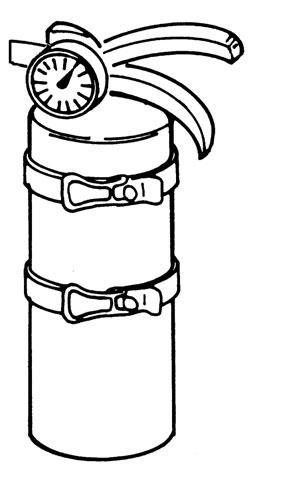
Always clean fluid spills. Do not use petrol or diesel fuel for cleaning parts. Use commercial non-flammable solvents.
Fueling
Stop the engine and let it cool before adding fuel. No smoking! Do not refuel a machine near open flames or sparks. Fill the fuel tank outdoors.
Ultra Low Sulfur Diesel (ULSD) poses a greater static ignition hazard than earlier diesel formulations with higher Sulfur content. Avoid death or serious injury from fire or explosion. Consult with your fuel or fuel system supplier to ensure the delivery system is in compliance with fueling standards for proper grounding and bonding practices.
Starting
Do not use ether or starting fluids on any engine that has glow plugs. These starting aids can cause explosion and injure you or bystanders.
Use the procedure in the Operation & Maintenance Manual for connecting the battery and for jump starting.
Spark Arrester Exhaust System
The spark arrester exhaust system is designed to control the emission of hot particles from the engine and exhaust system, but the muffler and the exhaust gases are still hot.
Check the spark arrester exhaust system regularly to make sure it is maintained and working properly. Use the procedure in the Operation & Maintenance Manual for cleaning the spark arrester muffler (if equipped).
Welding And Grinding
Always clean the machine and attachment, disconnect the battery, and disconnect the wiring from the Bobcat controllers before welding. Cover rubber hoses, battery and all other flammable parts. Keep a fire extinguisher near the machine when welding.
Have good ventilation when grinding or welding painted parts. Wear dust mask when grinding painted parts. Toxic dust or gas can be produced.
Dust generated from repairing non-metallic parts such as hoods, fenders or covers can be flammable or explosive. Repair such components in a well ventilated area away from open flames or sparks.
Fire Extinguishers
Know where fire extinguishers and first aid kits are located and how to use them. Inspect the fire extinguisher and service the fire extinguisher regularly. Obey the recommendations on the instructions plate.
Publications And Training Resources
The following publications are also available for your Bobcat excavator. You can order them from your Bobcat dealer. For the latest information on Bobcat products and the Bobcat Company, visit our Website at Bobcat.com/training or Bobcat.com
OPERATION & MAINTENANCE MANUAL
7349197enGB
- Complete instructions on the correct operation and the routine maintenance of the Bobcat excavator.
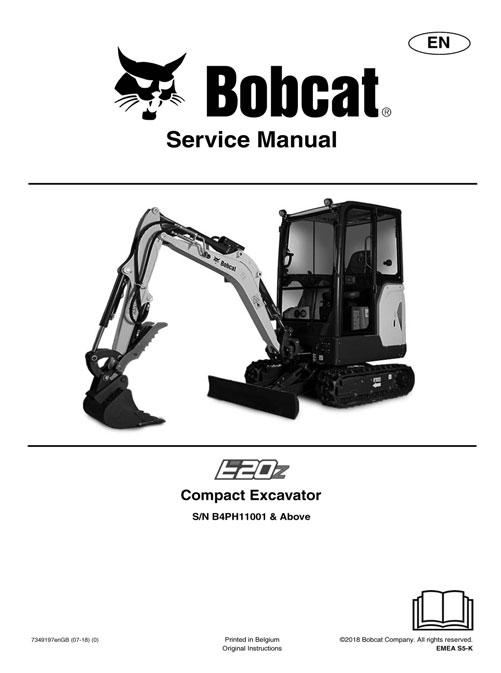
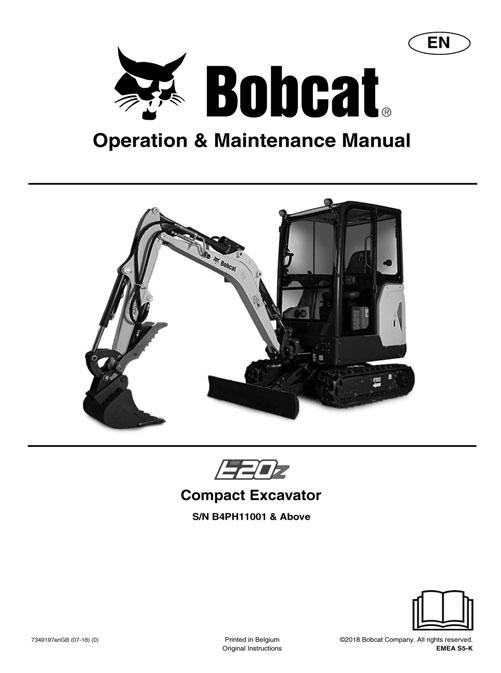
SERVICE MANUAL
7255008enUS
- Complete maintenance instructions for your Bobcat excavator.
OPERATOR’S HANDBOOK
7255186enGB
Gives basic operation instructions and safety warnings.
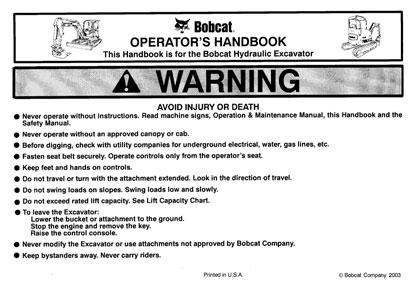
MACHINE SIGNS (DECALS)
Follow the instructions on all the Machine Signs (Decals) that are on the excavator. Replace any damaged machine signs and be sure they are in the correct locations. Machine signs are available from your Bobcat excavator dealer.



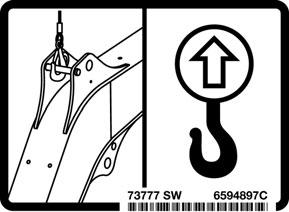

MACHINE SIGNS (DECALS) (CONT’D)
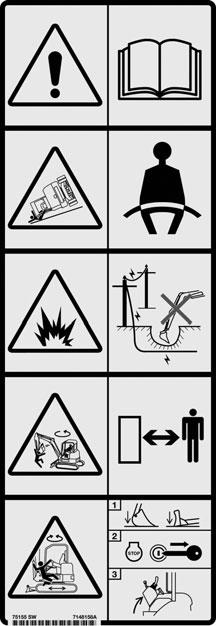
Follow the instructions on all the Machine Signs (Decals) that are on the excavator. Replace any damaged machine signs and be sure they are in the correct locations. Machine signs are available from your Bobcat excavator dealer.

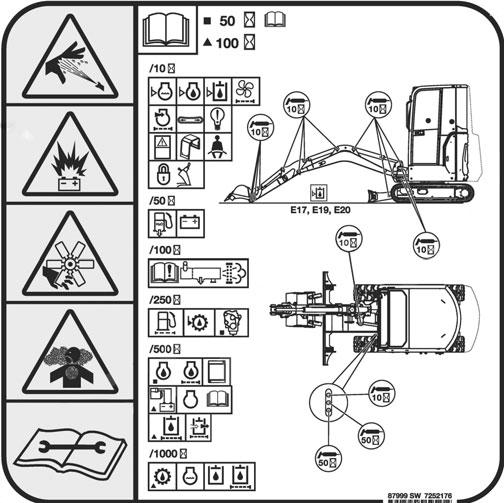
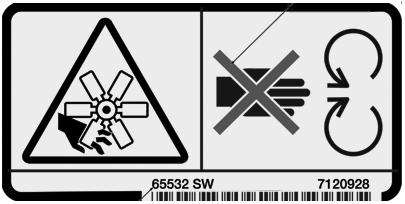
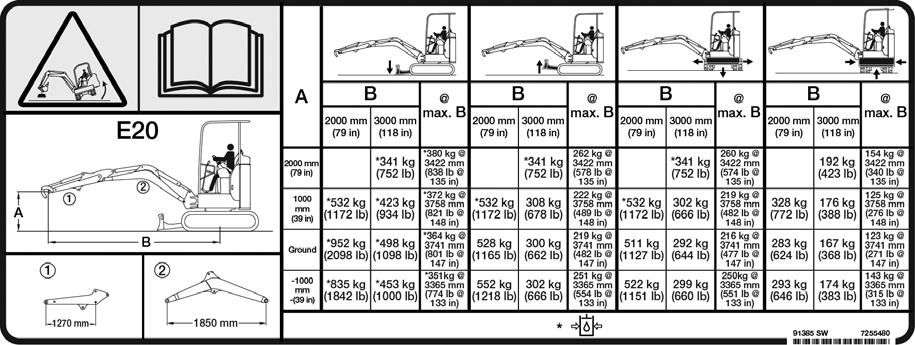
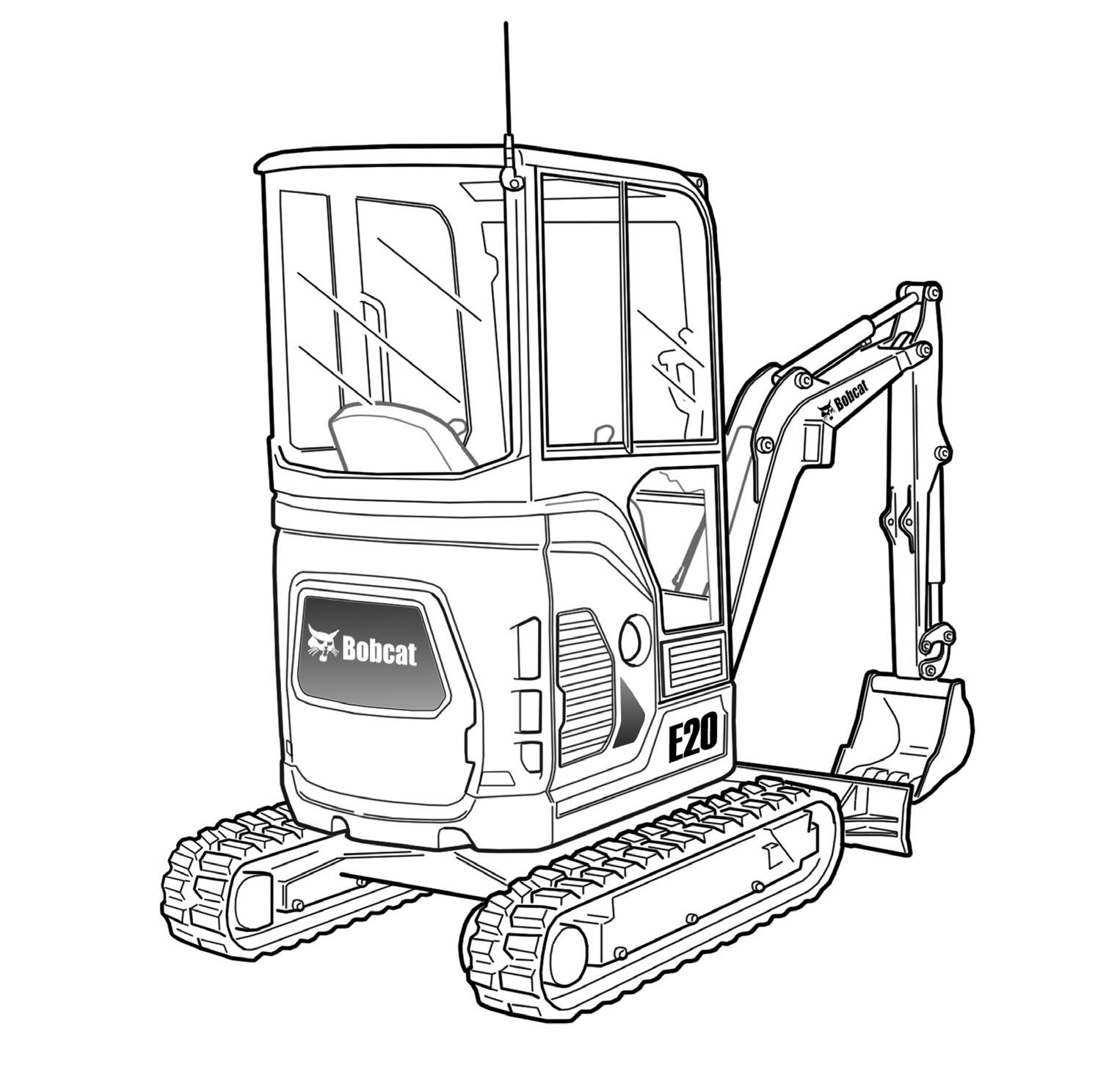
MACHINE SIGNS (DECALS) (CONT’D)
Pictorial Only Safety Signs
Safety signs are used to alert the equipment operator or maintenance person to hazards that may be encountered in the use and maintenance of the equipment. The location and description of the safety signs are detailed in this section. Please become familiarized with all safety signs installed on the excavator.
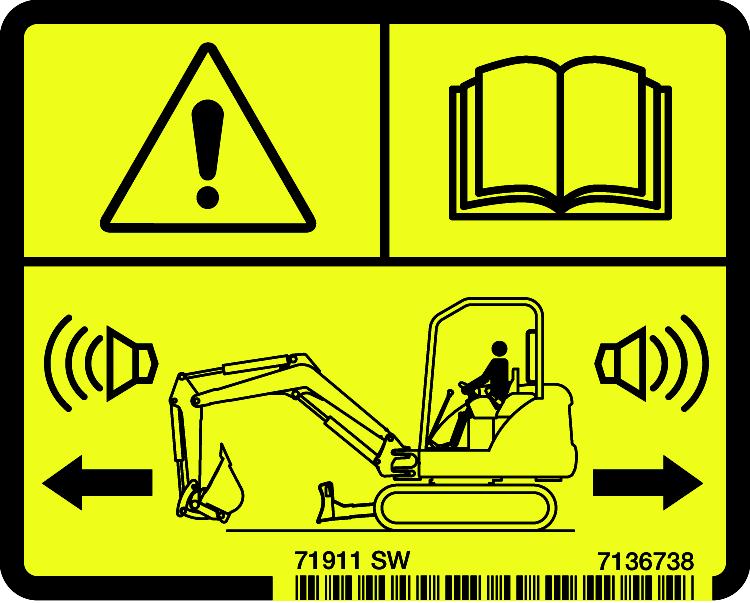
Vertical Configuration
NOTE: See the numbered MACHINE SIGNS (DECALS) on Page 16 and Machine Signs (Decals) (Cont’d) on Page 17 for the machine location of each corresponding numbered pictorial only decals as shown below.
1.Motion Alarm (7136738)
This safety sign is located on the right window (cab models), rear crossmember (canopy models).
HAZARD PANEL
AVOIDANCE PANEL
Horizontal Configuration
Warning
This machine is equipped with a motion alarm. ALARM MUST SOUND! when operating forward or backward.
Failure to maintain a clear view in the direction of travel could result in serious injury or death.
HAZARD PANEL AVOIDANCE PANEL
The format consists of the hazard panel(s) and the avoidance panel(s):
Hazard panels depict a potential hazard enclosed in a safety alert triangle.
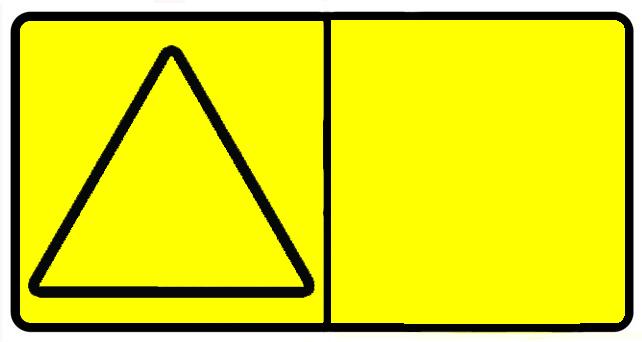

Avoidance panels depict actions required to avoid the hazards.
A safety sign may contain more than one hazard panel and more than one avoidance panel.
The operator is responsible for the safe operation of this machine.
W-2786-0309
MACHINE SIGNS (DECALS) (CONT’D)
Pictorial Only Safety Signs (Cont’d)

2.Control Pattern / Joystick (7251802, 7255944)
These safety signs are located on the left console and the right consoles by the joysticks.


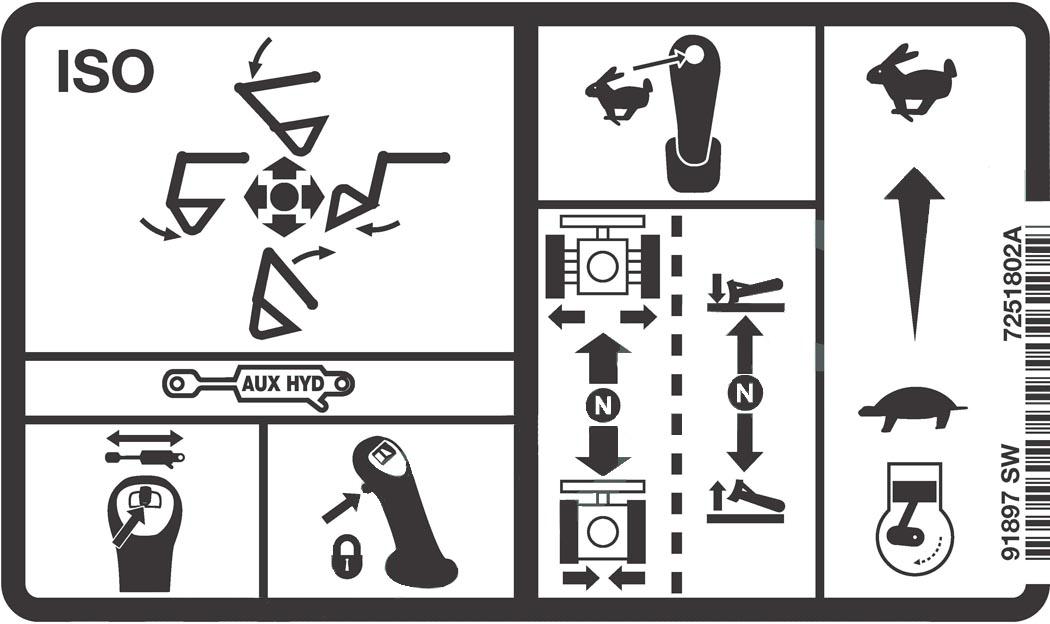
3.Crush Hazard (6713507)
This safety sign is located on both sides of the boom.
Warning
Keep away from the operating machine to avoid serious injury or death.
W-2520-0106
4.Thrown Or Flying Objects (7168039)
This safety sign is located on the outside of both track frame.
Warning
Know the control pattern before operating.
W-2989-0714
Warning
High pressure grease can cause serious injury. Do not loosen grease fitting. Do not loosen bleed fitting more than 1 - 1/2 turns.
Read and understand the Operation & Maintenance Manual for more information.
W-2516-0110
MACHINE SIGNS (DECALS) (CONT’D)
Pictorial Only Safety Signs (Cont’d)
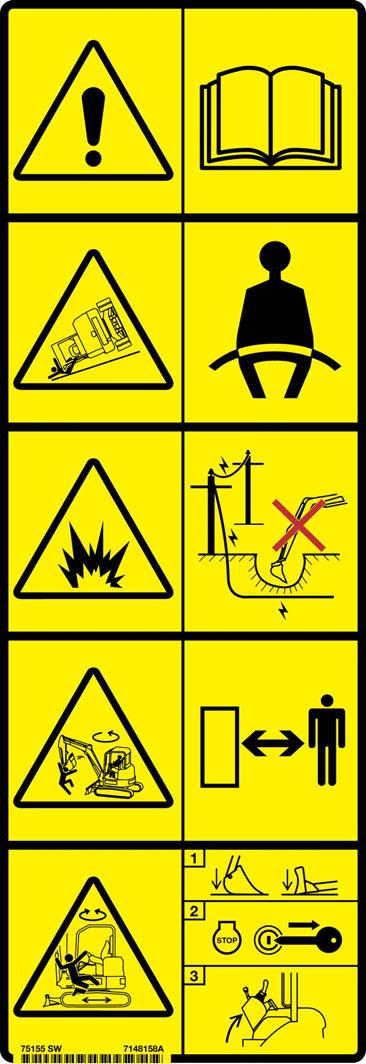
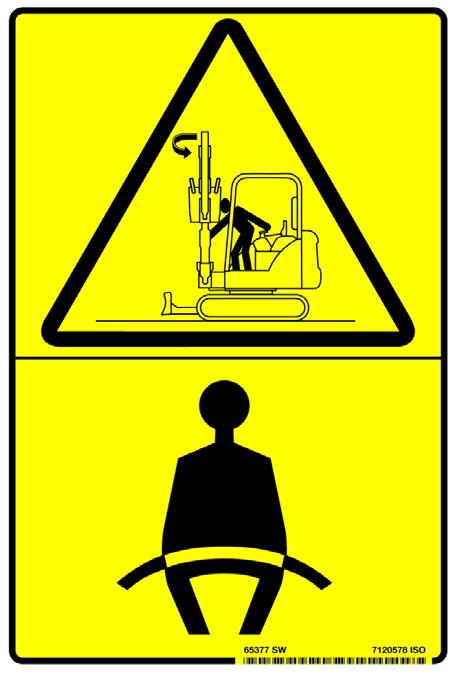
5.Transporting And Lifting (7178215)
This safety sign is located on the front of the cab.
Warning
Improper loading, transporting and lifting procedures can cause serious injury or death. Read and understand the Operation & Maintenance Manual prior to transporting or lifting the machine.
W-2517-0110
6.Transporting And Lifting (7120578)
This safety sign is located on the front of the cab.
Warning
•Keep out of swing area.
•Keep bystanders away.
•Operate the excavator from the operator’s position only.
W-2990-0714
7.General Hazard (7148158)
This safety sign is located inside the operator’s area on the left console.
Warning
Failure to obey warning signs and instructions can cause serious injury or death. Never use excavator without instructions. Read and understand the Operation & Maintenance Manual and Handbook.

Keep away from dropoffs, steep areas or banks that could break away.
Explosion or electrocution can occur if machine contacts utility lines or pipes. Check for overhead or underground lines before operating.
Keep bystanders away. No riders. Check location of blade for direction of travel before moving steering controls.
Failure to operate machine from the operator’s position can cause serious injury or death.
To Leave Excavator:
1. Lower attachment and blade to ground.
2. Stop engine and remove the key (if equipped).
3. Raise control console.
W-2518-0110
MACHINE SIGNS (DECALS) (CONT’D)
Pictorial Only Safety Signs (Cont’d)
8.Lift Capacity (7255477, 7350339, 7255478, 7350342, 7255479, 7350345, 7255480, 7350348)
This safety sign is located on the right window (cab models) or on the rear crossmember (canopy models).
9.Rotating Fan and Hot Surfaces (7120928)
This safety sign is located inside the engine compartment.
Warning
Overload can tip the excavator and cause serious injury or death.
•Do not lift or hold any load that exceeds these ratings at their specific load radii and height.

•Total rated load is shown. The weight of all lifting devices must be deducted to determine the net load that can be lifted.
Read and understand the Operation & Maintenance Manual for more information.
W-2519-0110
Warning
Rotating fan blade can cause serious injury or death. Keep away from fan and moving parts. Do not operate with guard removed.
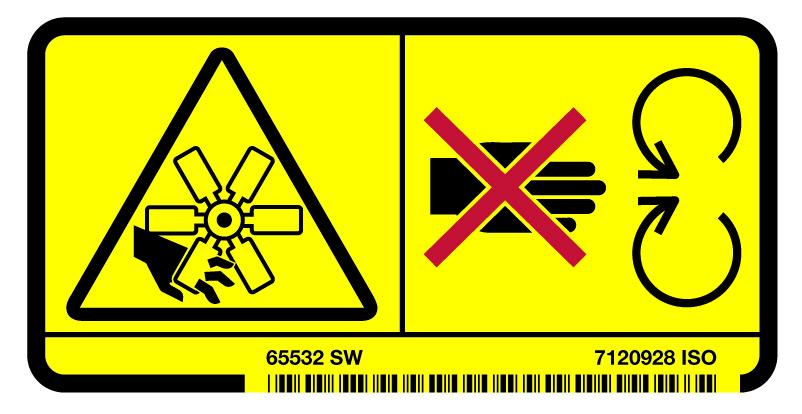
Hot surfaces can cause injury. Do not touch. Allow to cool before servicing.
W-2521-0106
MACHINE SIGNS (DECALS) (CONT’D)
Pictorial Only Safety Signs (Cont’d)
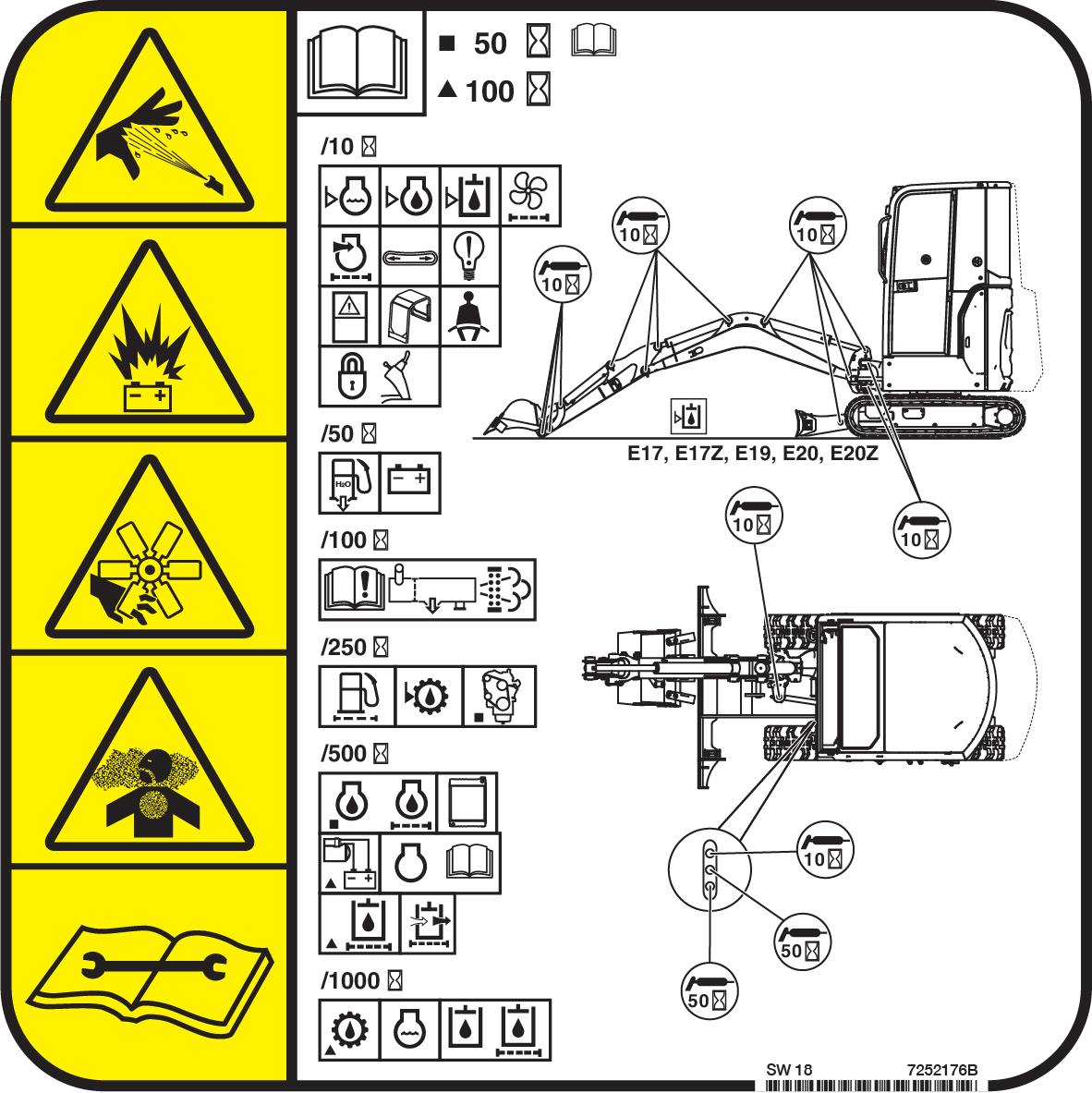
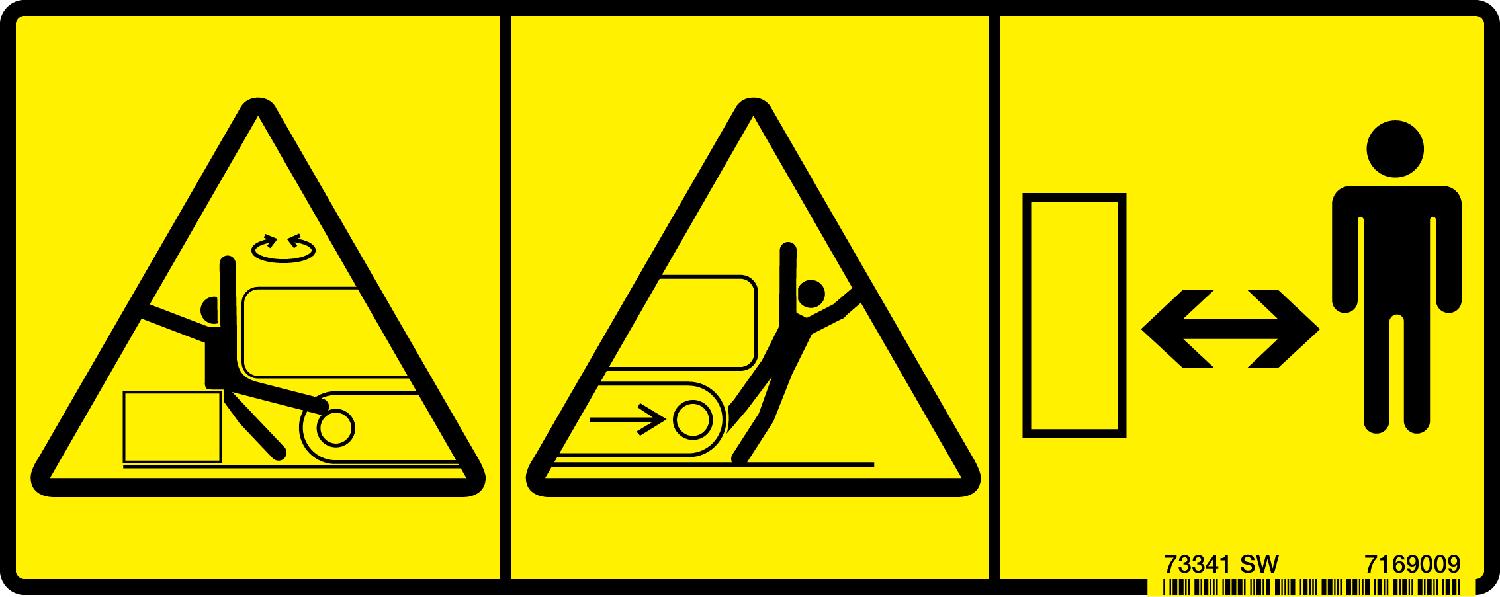
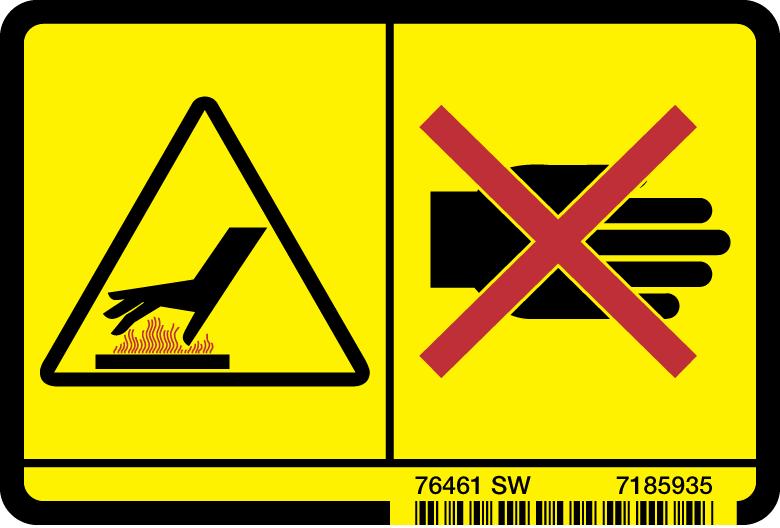
10.Hot Surfaces (7185935)
This safety sign is located in the right cover on the radiator and inside the engine compartment.
Warning
AVOID BURNS
Do not remove radiator cap when the engine is hot. You can be seriously burned.
W-2070-1203
11.Stay Away (7169009)
This safety sign is located on both upper rear corners of the upperstructure.
12.High Pressure, Battery, Rotating Fan, Exhaust Gases and Service Schedule (7252176)
This safety sign is located inside the tailgate.
Warning
AVOID INJURY OR DEATH
•Keep out of swing area or travel path.
•Always look in the direction of travel.
•Make sure swing area is clear of bystanders and objects.
W-2775-1208
Warning
Leaking fluids under pressure can enter the skin and cause serious injury or death. Immediate medical attention is required. Wear goggles. Use cardboard to check for leaks.
Battery makes flammable and explosive gas. Keep arcs, sparks, flames and lighted tobacco away. Keep away from electrical contacts
Rotating fan can cause serious injury. Keep away from fan and moving parts. Do not operate with guard removed.
All exhaust gases can kill. Always ventilate.
Read and understand the Operation & Maintenance Manual for more information.
W-2522-0110
Intended Use
This machine is classified as an Excavator as defined in ISO 6165. This machine has tracks and commonly a mounted bucket for the principle intended functions of excavating, loading and backfilling loose materials such as earth, gravel, or crushed rock.


Additional Bobcat approved attachments allow this machine to perform other tasks described in the attachment Operation & Maintenance Manuals.
Examples of intended use include:
Excavating
Warning
AVOID INJURY OR DEATH
Check area to be excavated for overhead or underground electrical power lines. Keep a safe distance from electrical power lines.
Warning
AVOID INJURY OR DEATH
Do not exceed rated lift capacity. Excessive load can cause tipping or loss of control.
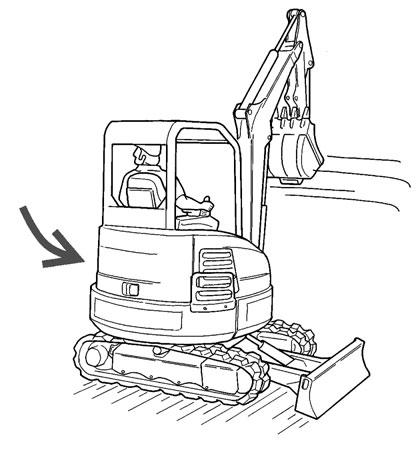
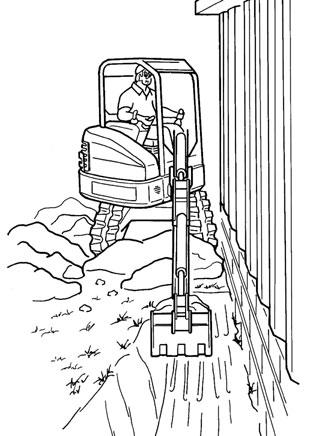
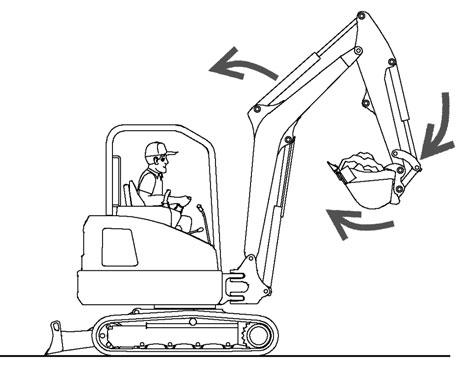
W-2374-0500
W-2757-EN-0513
Warning
Keep all bystanders 6 m (20 ft) away from equipment when operating. Contact with moving parts, a trench cave-in or flying objects can cause injury or death.
Avoid impacting objects with the blade. Damage to blade and undercarriage components may occur.
I-2256-0507

Instruments And Consoles
Cab Interior Light

Interior light is equipped on excavators with a cab.
1 Left Joystick (See HYDRAULIC CONTROLS on Page 45.)
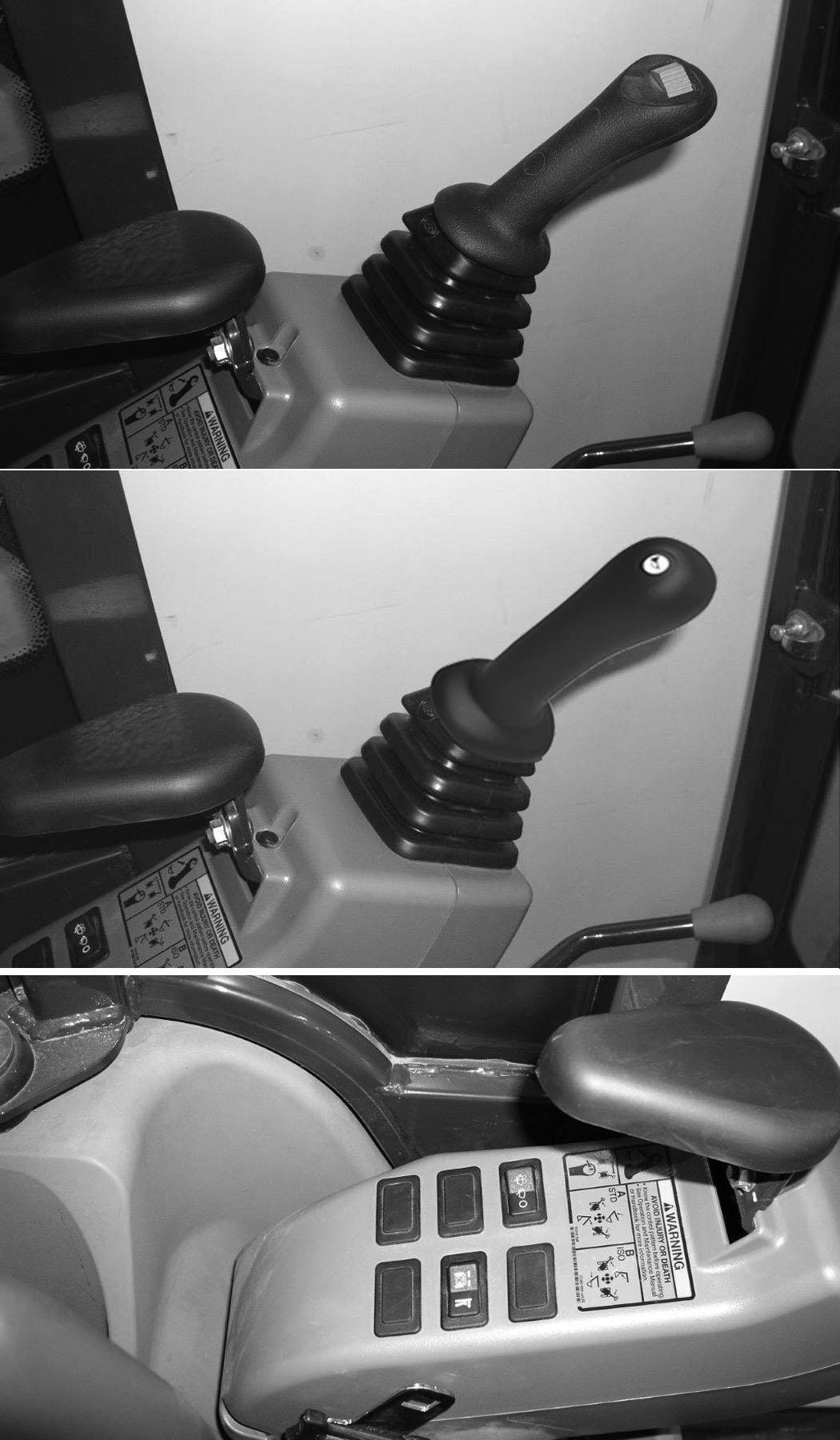
2 HornPress the button on the left joystick to sound horn.
3 Boom Swing Switch (If Equipped)
Press the switch to the right (Item 1) to turn the light ON. Press the switch to the left (Item 2) [Figure 6] to turn the light OFF.
4 Wiper / Washer Switch (If Equipped)
Move the switch to the left to swing the boom to the left. Move the switch to the right to swing the boom to the right. NOTE: For machine not equipped with switch (Item 3) in the left joystick, (See BOOM SWING on Page 54.)
Press the switch to the left to turn wiper ON. Press and hold switch to the left to activate window washer. Press the switch to the right to turn wiper OFF.
5 Not Used- - -
6 Beacon / Strobe Light (If Equipped)
7 Overload Warning Device Switch (If Equipped)
8 Blade / Track RetractionExpansion Switch
Press switch to the left to turn ON the beacon / Strobe light. Press the switch to the right to turn OFF.
Press the switch to the left to turn the overload warning device ON. Press to the right to turn OFF. (See OVERLOAD WARNING DEVICE on Page 59.)
Press the switch to the left to expand / retract the tracks. Press the switch to the right to raise and lower the boom. (See TRACK EXPANSION in this manual.)
9 Not Used- - -
INSTRUMENTS AND CONSOLES (CONT’D)
Right Console
Figure 8
REF DESCRIPTION
FUNCTION / OPERATION
1 Right Joystick(See HYDRAULIC CONTROLS on Page 45.)
2 Auxiliary Hydraulic Switch (If Equipped)
3 Blade Control Lever / Track Retraction - Expansion Lever
Controls the fluid flow to the auxiliary quick couplers (attachment). (See Auxiliary Hydraulics - Joystick Controls on Page 47.) NOTE: For machine not equipped with switch (Item 2) in the right joystick, see Auxiliary Hydraulic Pedal information. (See Auxiliary Hydraulics - Manual Controls on Page 48.)
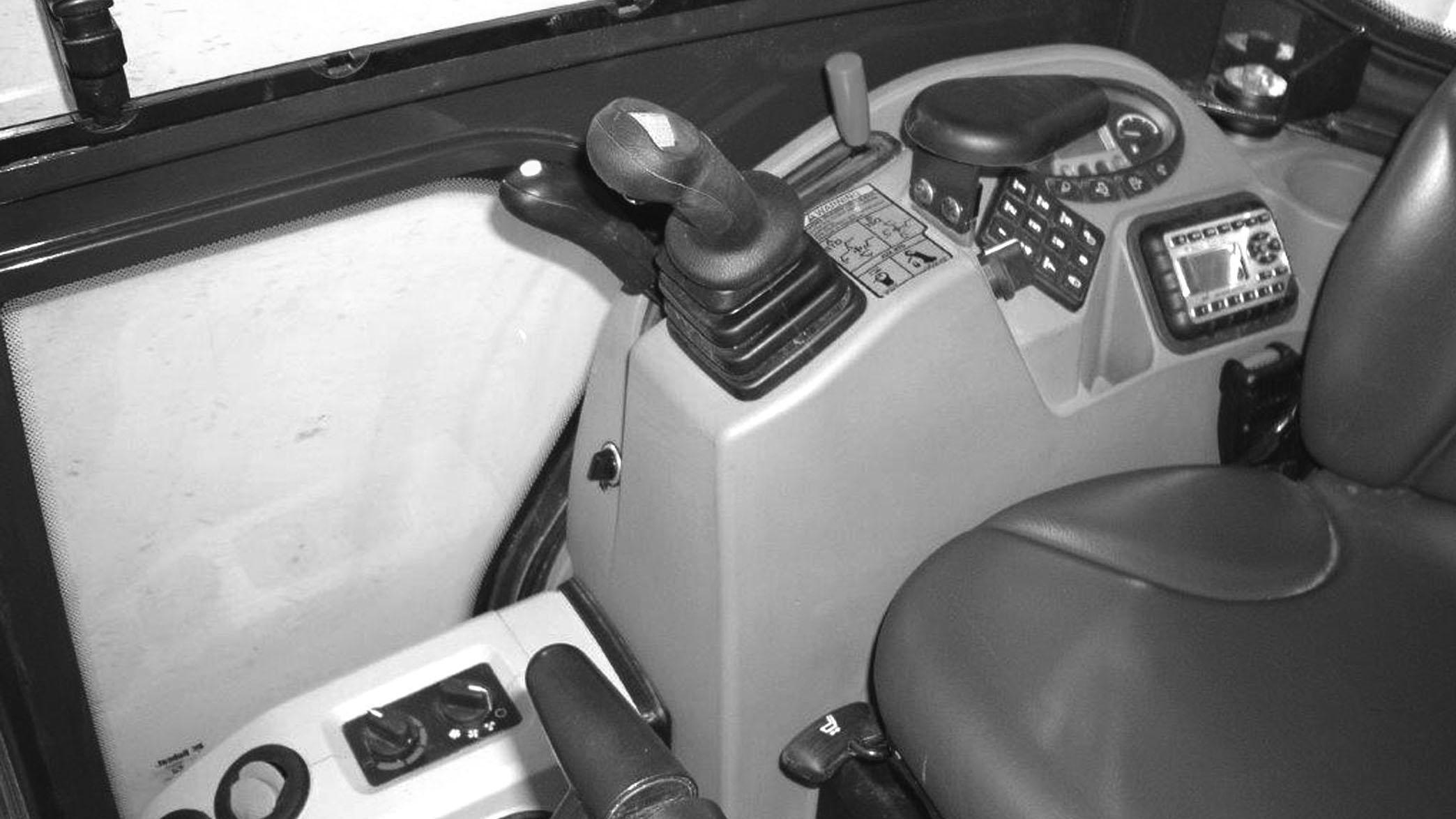
Controls raising and lowering the blade. (See BLADE CONTROL LEVER on Page 51.) Controls extending and retracting the tracks. (See TRACK FRAME RETRACTION - EXPANSION on Page 52.)
4 Engine Speed Control LeverControls rpm of the engine. (See ENGINE SPEED CONTROL on Page 51.)
5 Two-Speed ButtonEngages and disengages High Range Travel Speed. (See Two-Speed Travel on Page 35.) and (See Auto Shift Drive Motors on Page 35.)
6 Auxiliary Power Outlet12 volt receptacle for accessories.
7 Key Switch / Rotary Start SwitchAlways perform the PRE-STARTING PROCEDURE (See PRE-STARTING PROCEDURE on Page 62.) before starting the engine. (See STARTING THE ENGINE on Page 65.)
8 Fan Motor Switch (If Equipped)Turn clockwise to increase fan speed; anticlockwise to decrease.
9 Temperature Control (If Equipped)
Turn clockwise to increase temperature; anticlockwise to decrease.
10 Instrument Panel(See Instrument Panel on Page 29.)
11 Keypad (If Equipped)Enter the password to start the engine. (See Keyless on Page 66.)
12 Radio (If Equipped)(See Radio Option on Page 32.)
NOTE:Always turn key switch and all accessories to OFF position when the engine is stopped, the battery will discharge if the key is left ON.
INSTRUMENTS AND CONSOLES (CONT’D)
Instrument Panel

9
FUNCTION / OPERATION
1 LightsPress once for work lights. (Left green LED illuminates.) Press again to turn all lights off. (Left green LED off.)
2 Auto Idle Feature (NOT USED FOR THIS MODEL)
3 Auxiliary Hydraulic Button (Used With Joystick Switch Activated Auxiliary Hydraulics Only)
Press and hold 5 seconds to display software version in display screen.
Press once to enable auxiliary hydraulic function. (Left green LED illuminates.)
See Auxiliary Hydraulics in this manual (See Auxiliary HydraulicsJoystick Controls on Page 47.) or (See Auxiliary Hydraulics - Manual Controls on Page 48.)
4 InformationCycles through (after each button press) (The following information is displayed in the Data Display Screen, Item 6):
•Hourmeter (On startup)
•Job Clock (1 and 2)
•Engine rpm
•Battery voltage
•Maintenance clock (Press and hold 7 seconds when displayed to reset the maintenance clock.)
•Service codes*
5 Engine Temperature GaugeShows the engine coolant temperature.
INSTRUMENTS AND CONSOLES (CONT’D)
Instrument Panel (Cont’d)
REF. NO.
Description
FUNCTION / OPERATION
6 Data Display ScreenThe data display screen shows the Hourmeter at start up and then changes to engine rpm during normal operation of the excavator. When preheat is activated, the display screen will show the remaining preheat time. Can also be used to display Job Clock, Engine rpm, and Selectable Auxiliary Hydraulic Flow. (See Data Display Screen on Page 31.)
7 Fuel GaugeShows the amount of fuel in the tank. 8 Seat BeltFasten Seat Belt Reminder - Light stays on for 45 seconds to remind operator to fasten seat belt.
for this
11 Left Console LockoutIcon ON when left console is raised. Icon OFF when left console is lowered. 12 General Warning **Malfunction with one or more machine functions. (See Service Codes in this manual.) 13
* See SYSTEM SETUP AND ANALYSIS for Service Code Description. (See DIAGNOSTIC SERVICE CODES on Page 142.)
** Icons will be ON or flashing when diagnostic system indicates a problem. (See DIAGNOSTIC SERVICE CODES on Page 142.)
*** Icons will be flashing when diagnostic system indicates a problem. (See DIAGNOSTIC SERVICE CODES on Page 142.)
INSTRUMENTS AND CONSOLES (CONT’D)
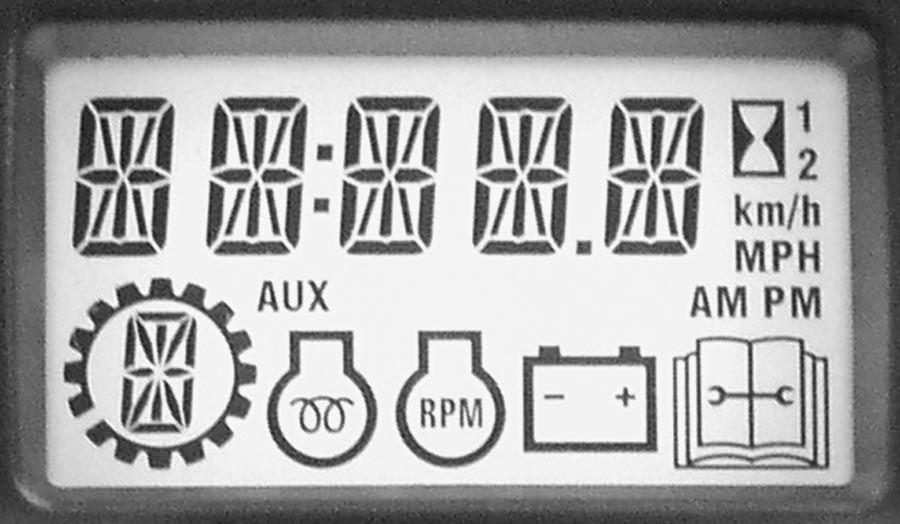
Data Display Screen
Indicator Icons
The display screen can display the following information:
•Operating hours
•Job Clock (1 and 2)
•Engine rpm
•Battery voltage
•Maintenance clock countdown
•Service codes
Figure 10
The display screen is shown in [Figure 10]. The data display will show operating hours upon startup.
INSTRUMENTS AND CONSOLES (CONT’D)
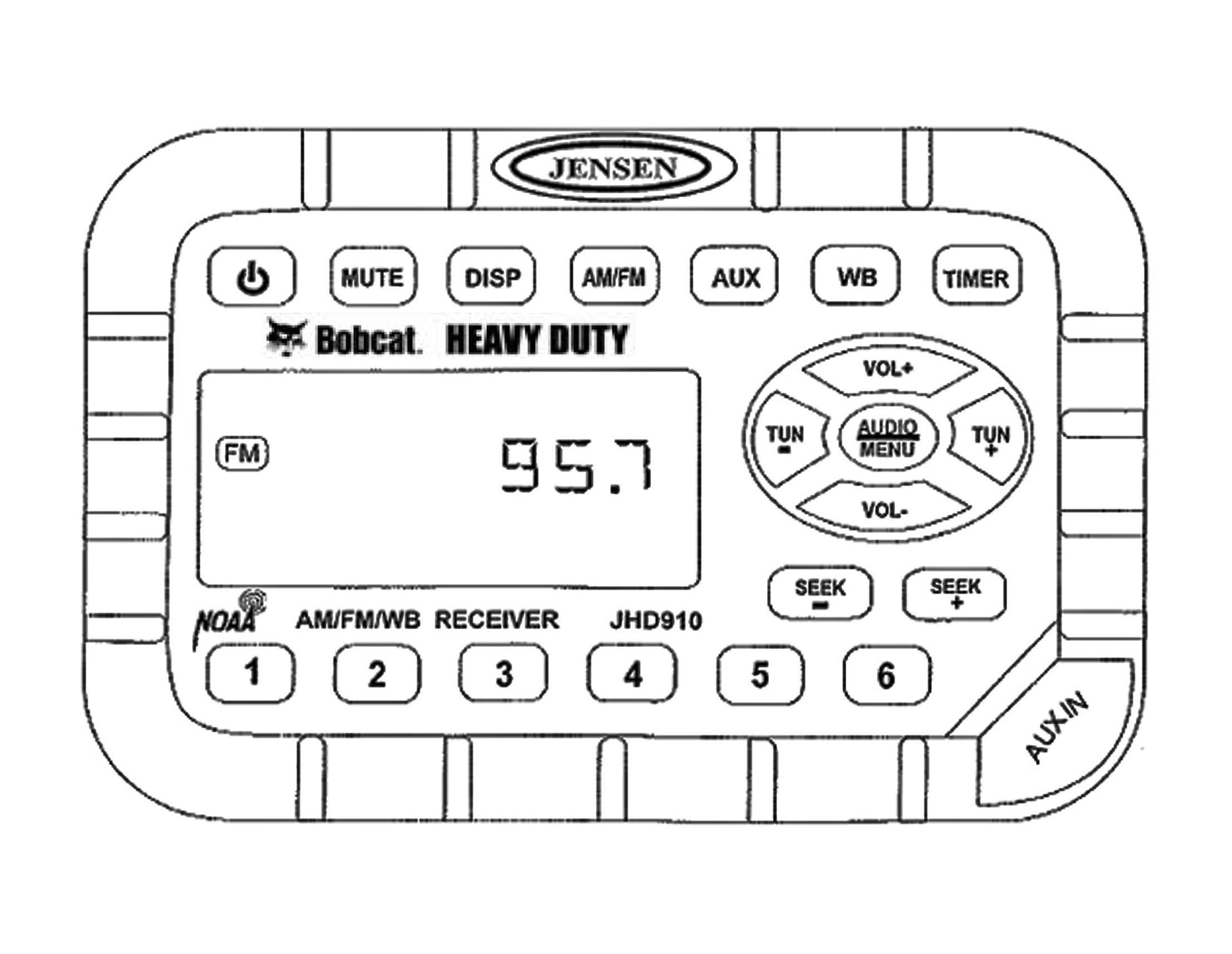
Radio Option
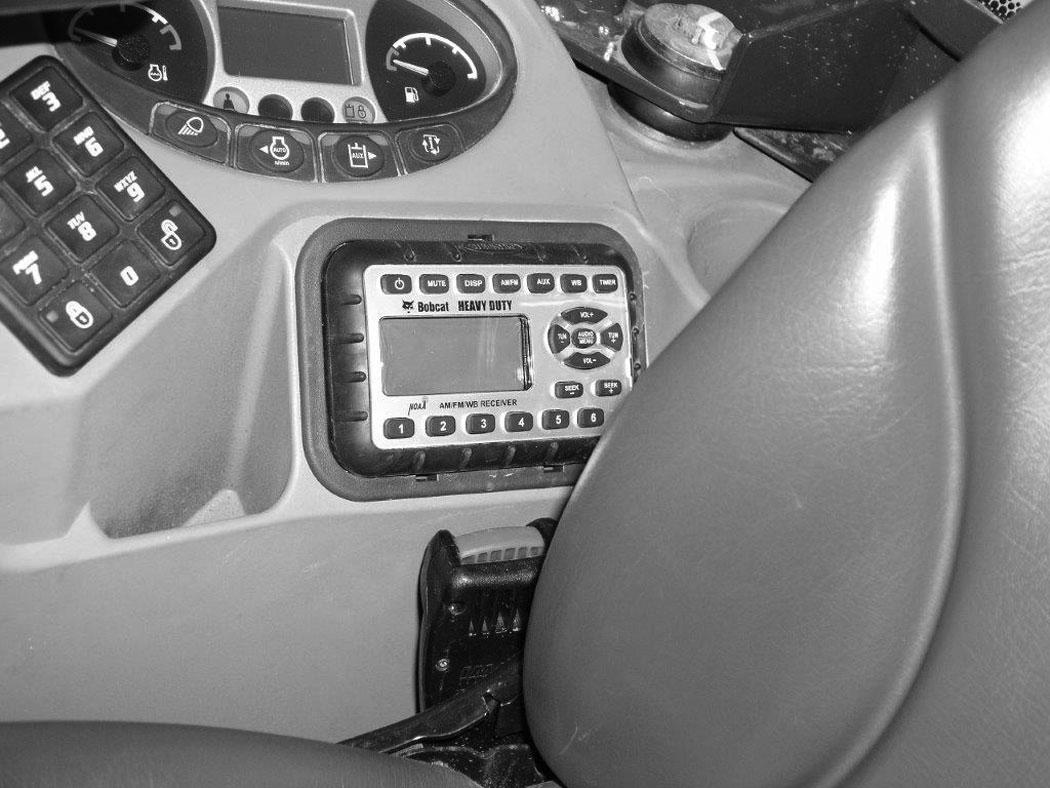
11
8
P113383 1 9 11 12 13 14 15 17
2 3 4 5 6 7 10 16
INSTRUMENT AND CONSOLES (CONT’D)
Radio Option (Cont’d)
REF.
NO. DESCRIPTION
FUNCTION / OPERATION
1POWERPress to turn ON; press again to turn OFF.
2MUTEPress to mute audio output; [MUTE] will appear in display screen; press again to turn OFF.
3DISPLAYPress to toggle between function mode (showing tuner frequency, auxiliary input, weather band information, or timer) and clock mode.
Press and hold to enter clock setting mode; use FREQUENCY DOWN (TUN -) button to adjust hours and FREQUENCY UP (TUN +) button to adjust minutes; normal operation will resume automatically.
4BANDPress to select tuner mode. Press to cycle through 2 AM (MW) bands and 3 FM bands.
5AUXILIARYPress to select Auxiliary Input mode. Portable audio device (MP3 player) must be attached to auxiliary input jack.
6WEATHER BANDPress to select weather band; use FREQUENCY UP (TUN +) and FREQUENCY DOWN (TUN -) buttons to adjust to the clearest station. The weather alert feature, if activated, will automatically switch from the current function to the weather band if a weather warning is received. See AUDIO / MENU ADJUSTMENT in this table.
7TIMERPress to access timer mode. Press to start the timer function; press again to stop timer; press again to resume timer or press and hold to reset timer and exit from timer mode.
8DISPLAY SCREENDisplays the time, frequency, and activated functions.
9VOLUME UPAdjusts volume up; current volume (0 - 40) will appear briefly in display screen.
10AUDIO / MENU ADJUSTMENT AUDIO ADJUSTMENT: Press to cycle through bass, treble, and balance settings; use VOLUME UP (VOL +) and VOLUME DOWN (VOL -) buttons to adjust when desired option is displayed; normal operation will resume automatically.
MENU ADJUSTMENT: Press and hold for 3 seconds to enter menu adjustment settings; press to cycle through the following settings; use VOLUME UP (VOL +) and VOLUME DOWN (VOL -) buttons to adjust when desired option is displayed; normal operation will resume automatically.
• Beep Confirm (On or Off) - Determines if beep will sound with each button press.
• Operation Region (USA or Europe) - Selects the appropriate region.
• Clock Display (12 or 24) - Selects a 12-hour or 24-hour clock display.
• Display Brightness (Low, Medium, or High) - Determines brightness level of display screen.
• Backlight Colour (Amber or Green) - Determines backlight colour of display screen.
• Power On Volume (0 - 40) - Selects default volume setting when radio is turned on.
• WB Alert (On or Off) - Determines if weather band alert feature is activated.
11FREQUENCY DOWNPress to manually tune the radio frequency down.
12FREQUENCY UPPress to manually tune the radio frequency up.
13VOLUME DOWNAdjusts volume down; current volume (0 - 40) will appear briefly in display screen.
14SEEK FREQUENCY DOWN Press to automatically tune frequency down to next strong station.
15SEEK FREQUENCY UP Press to automatically tune frequency up to next strong station.
16PRESET STATIONSUsed to store and recall stations for each AM and FM band. Press and hold to store current station; press button to recall station.
17AUXILIARY INPUT JACK Connect line output of portable audio device (MP3 player) to 3,5 mm (1/8 in) jack and press AUXILIARY button.
INSTRUMENTS AND CONSOLES (CONT’D)
Raising And Lowering The Console
Raise the console before exiting the cab.
Figure 13
Pull up on the release handle [Figure 13]. The lift spring will assist in raising the console.
Lower the console before operating the excavator.
Push down on the console [Figure 13] until the latch is engaged.

NOTE:When the console is raised, the hydraulic and traction system functions are locked and will not operate.
If the engine stops, the boom / bucket (attachments) can be lowered to the ground using hydraulic pressure in the accumulator.
The control console must be in the locked down position, and the key switch in the ON position.
INSTRUMENTS AND CONSOLES (CONT’D)
Two-Speed Travel
Auto Shift Drive Motors
The travel motors may be equipped with an auto shift feature that senses hydraulic pressure. When in high range, the travel motors will automatically shift to low range when more torque is required and return to high range when hydraulic pressure decreases.
NOTE:Always set the travel speed to low range when loading or unloading the excavator onto a transport vehicle.
Press the button (Item 1) [Figure 14] to engage the high range. Press a second time to disengage.
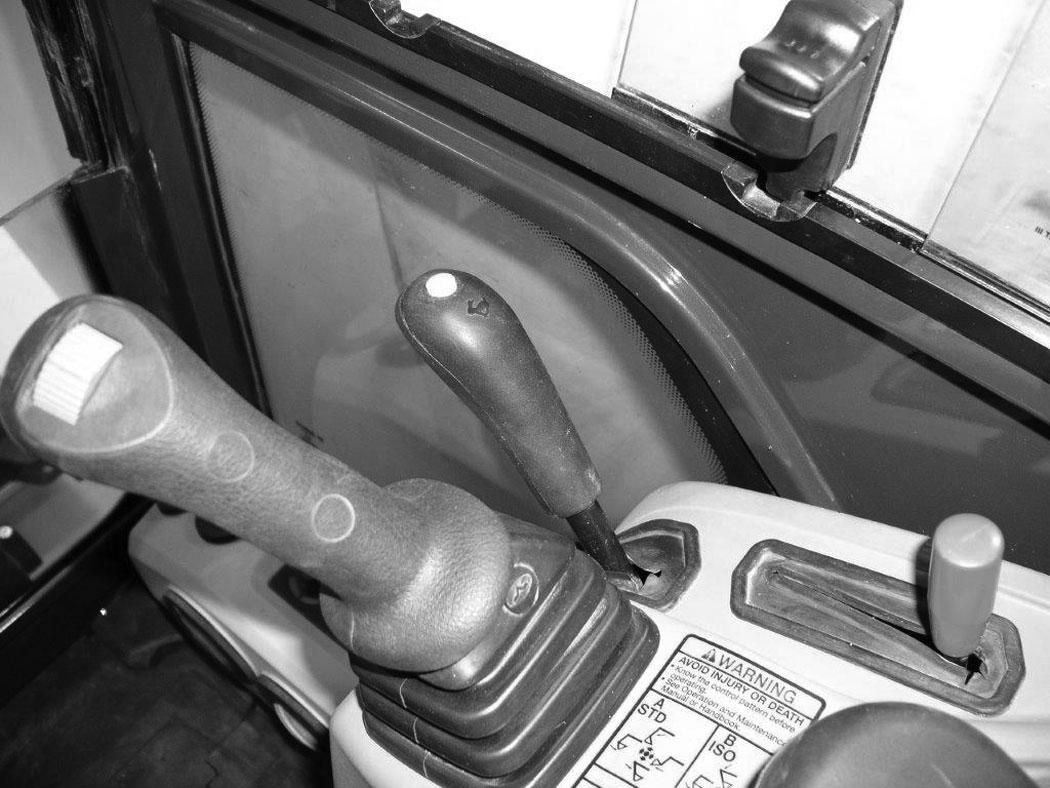
NOTE:When engaging high range, two audible beeps will be heard. When engaging low range, one audible beeps will be heard.
When high range is engaged, the two-speed travel icon (Item 1) [Figure 15] will illuminate.
Press the button (Item 1) [Figure 14] again to disengage.
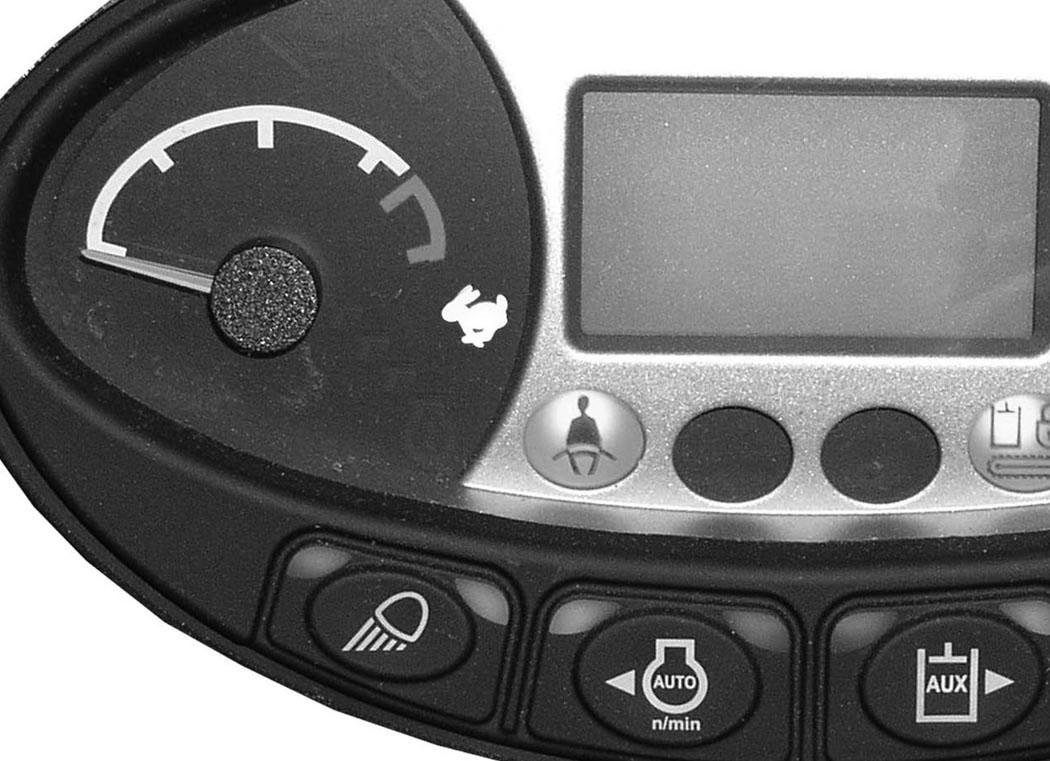
OPERATOR CANOPY (ROPS / TOPS / FOPS)
Description
The Bobcat excavator has an operator canopy (ROPS / TOPS / FOPS) as standard equipment to protect the operator if the excavator is tipped over. The seat belt must be worn for ROPS / TOPS / FOPS protection.
Check the ROPS / TOPS / FOPS canopy, mounting, and hardware for damage. Never modify the ROPS / TOPS / FOPS canopy. Replace the canopy and hardware if damaged. See your Bobcat dealer for parts.
ROPS - Roll-Over Protective Structure per ISO 121172:2008.
TOPS - Tip-Over Protective Structure per ISO 12117:2000, EN13531:2001.
FOPS - Falling-Object Protective Structure per ISO 10262:1998 - Meets Level 1.
Warning
Never modify operator cab by welding, grinding, drilling holes or adding attachments unless instructed to do so by Bobcat Company. Changes to the cab can cause loss of operator protection from rollover and falling objects, and result in injury or death.
W-2069-0200
OPERATOR CAB (ROPS / TOPS)
Description
The Bobcat excavator has an optional operator cab (ROPS / TOPS) as standard equipment to protect the operator if the excavator is tipped over. The seat belt must be worn for ROPS / TOPS protection.
Check the ROPS / TOPS cab, mounting, and hardware for damage. Never modify the ROPS / TOPS cab. Replace the cab and hardware if damaged. See your Bobcat dealer for parts.
ROPS / TOPS - Roll-Over Protective Structure per ISO 12117-2:2008, and Tip-Over Protective Structure per ISO 12117:2000, EN13531:2001.
Warning
Never modify operator cab by welding, grinding, drilling holes or adding attachments unless instructed to do so by Bobcat Company. Changes to the cab can cause loss of operator protection from rollover and falling objects, and result in injury or death.
W-2069-0200
OPERATOR CAB (ROPS / TOPS) (CONT’D)
Cab Door
16
Push the door all the way open until the latch post (Item 1) engages in the latch (Item 2) [Figure 17] to hold the door

From inside the cab, to open the door, pull on the latch (Item 1) [Figure 20] and open the door.
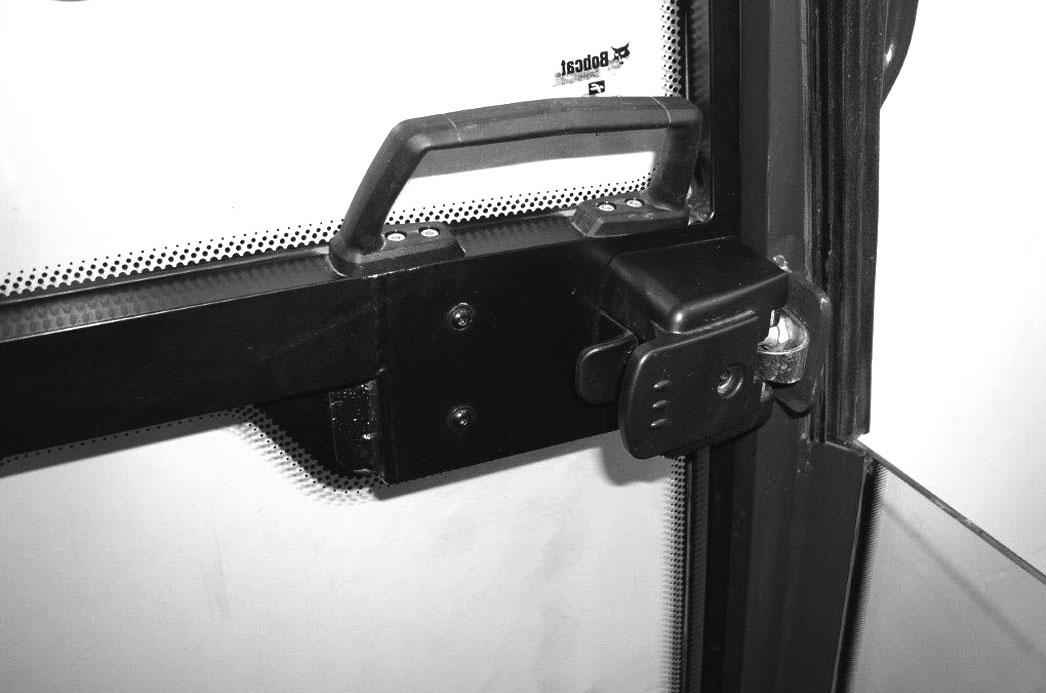

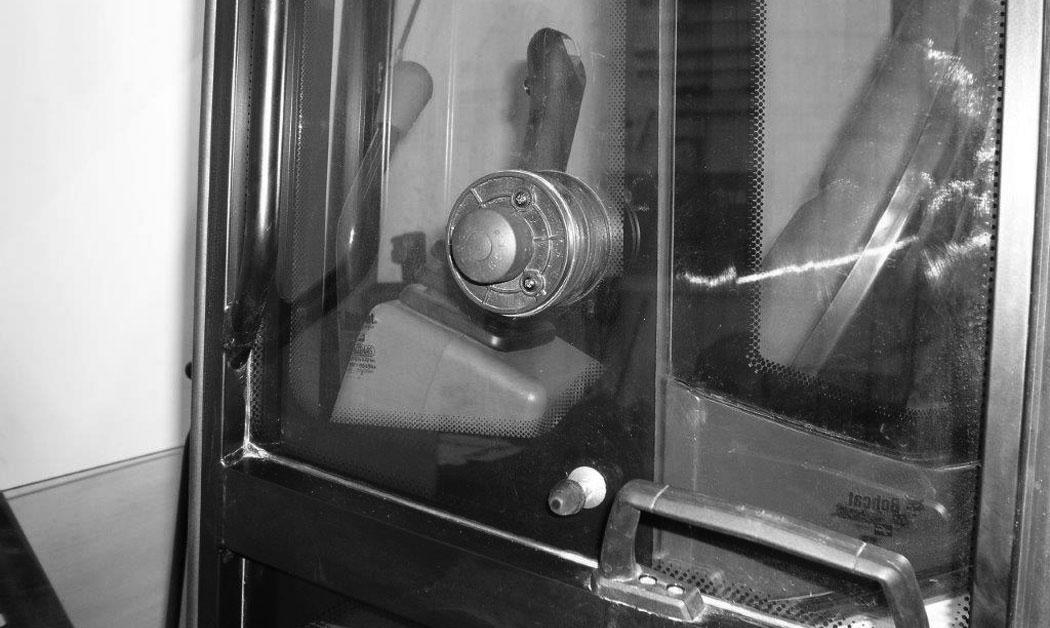
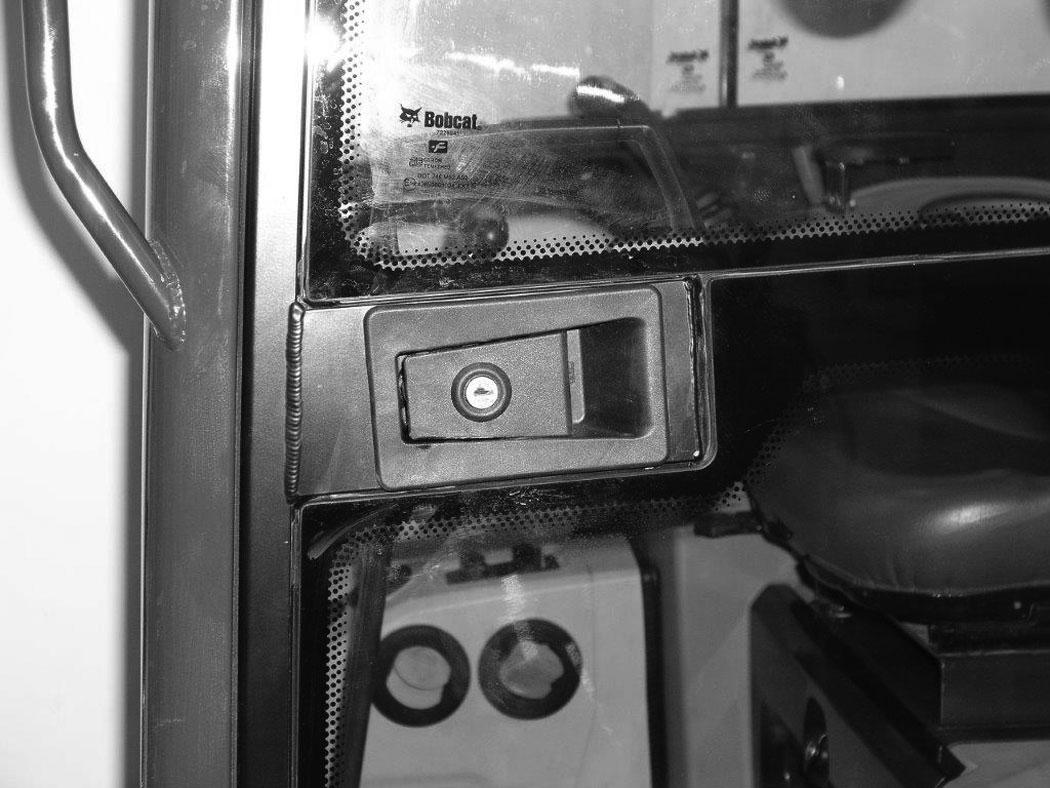
OPERATOR CAB (ROPS / TOPS) (CONT’D)

Front Window
Opening The Front Window
Figure 21
Press the window latch button (Item 1) [Figure 21] (both sides).
When the window is fully raised, the latch (Item 1) [Figure 23] (both sides) will close on the bracket in the latched position.
Pull down and forward slightly on the window to make sure it is fully latched.
Closing The Front Window
Use both window grab handles to support the window while pressing the window latch button (Item 2) [Figure 23] (both sides).
Use both window grab handles (Item 1) [Figure 22] to pull the window down fully.
Press the top of the window in until the latch locks into the latched position (both sides) [Figure 21]
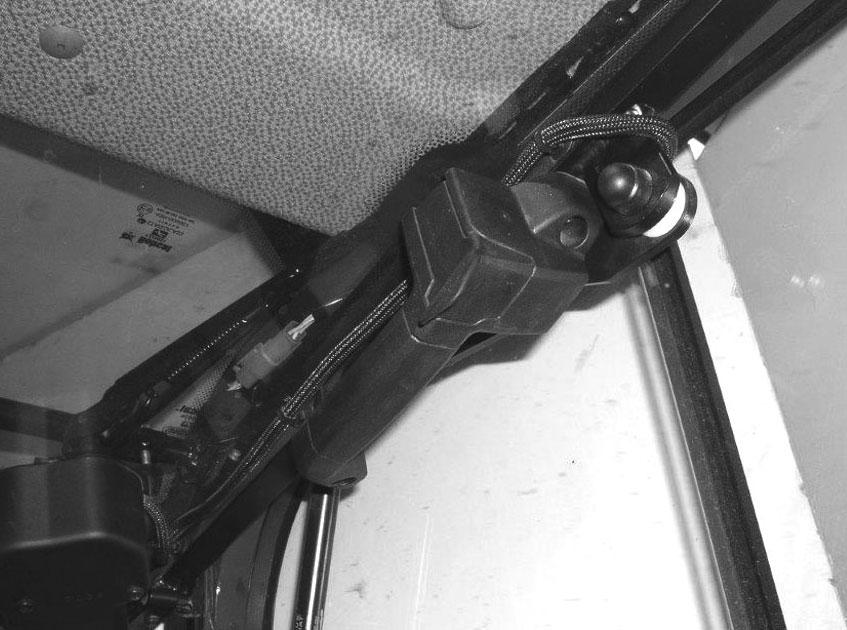
Pull inward and upward slightly on the window to make sure it is fully latched in the closed position.
Use both window grab handles (Item 1) [Figure 22] to pull the top of the window in.
Continue moving the window in and up over the operator’s head until the window is fully raised.

OPERATOR CAB (ROPS / TOPS) (CONT’D)
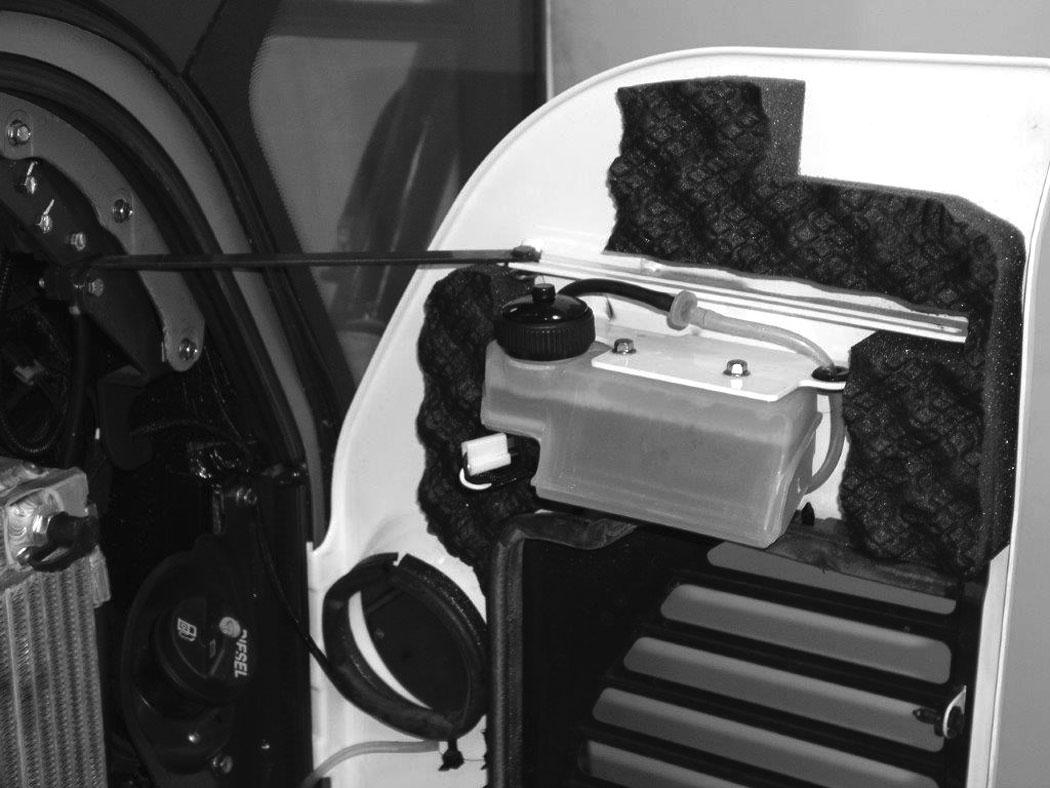
Front Wiper
Figure 24
Window Washer Reservoir
NOTE:When temperatures are to reach below freezing, use a washer fluid that is recommended for use in cold temperatures to avoid damage to the
Right Side Window
Opening The Right Front Window
Figure 26
Closing The Right Front Window down on the latch (Item 1) [Figure 26] and push the latch forward to close the window.
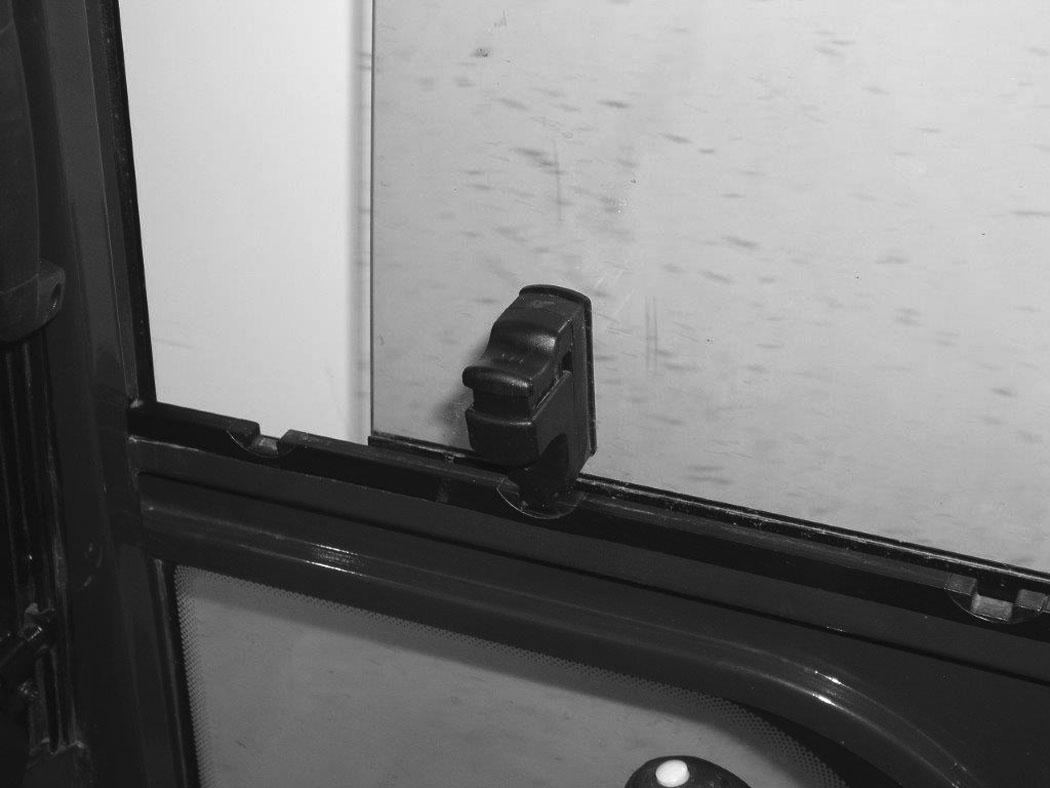

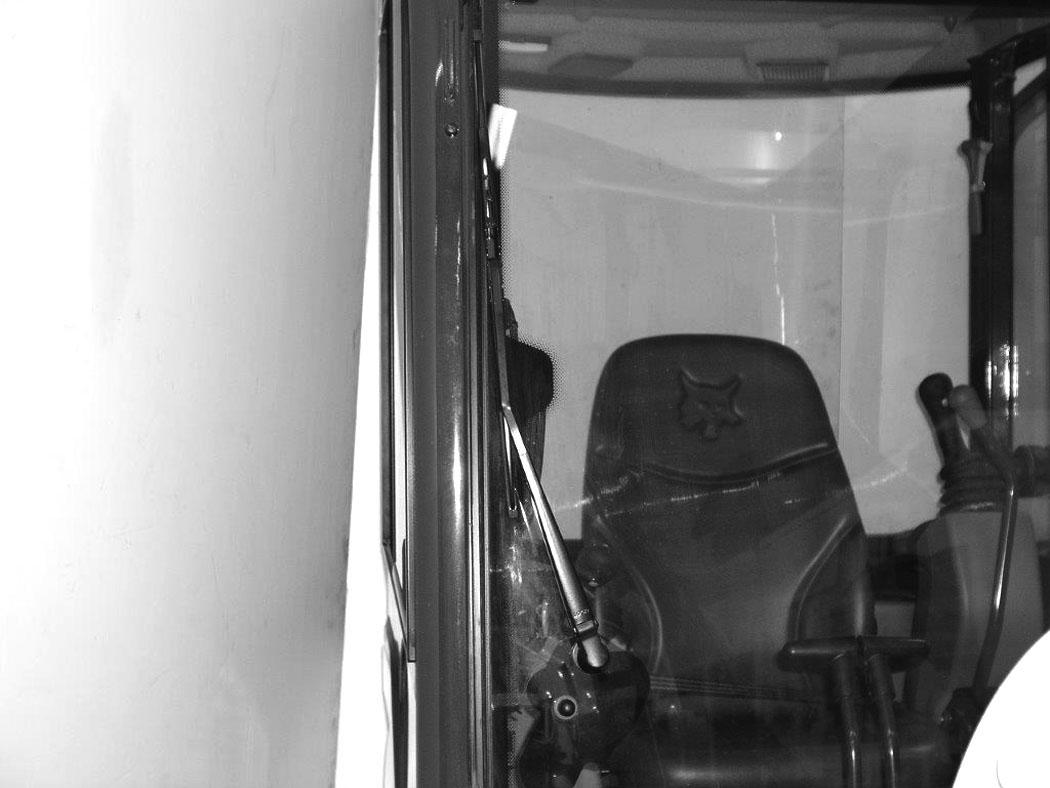
OPERATOR CAB (ROPS / TOPS) (CONT’D)
Heating And Ventilation Ducting
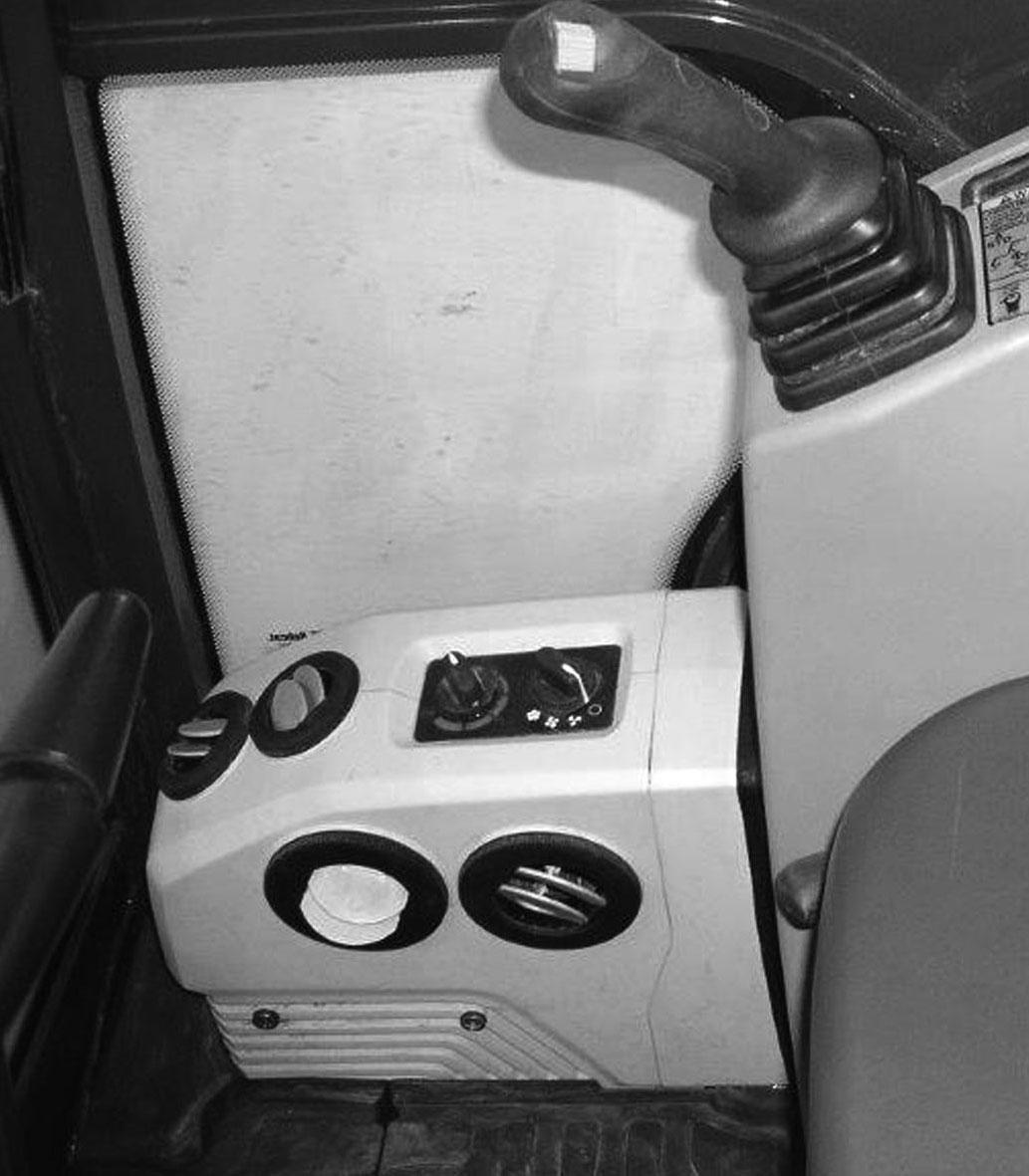
Emergency Exit
The door, the rear window and the front window provide exits.
Side Or Rear Window
Figure 29
If emergency exit requires breaking a window, use the supplied hammer (Item 1) [Figure 29] located on the left rear side of the cab.
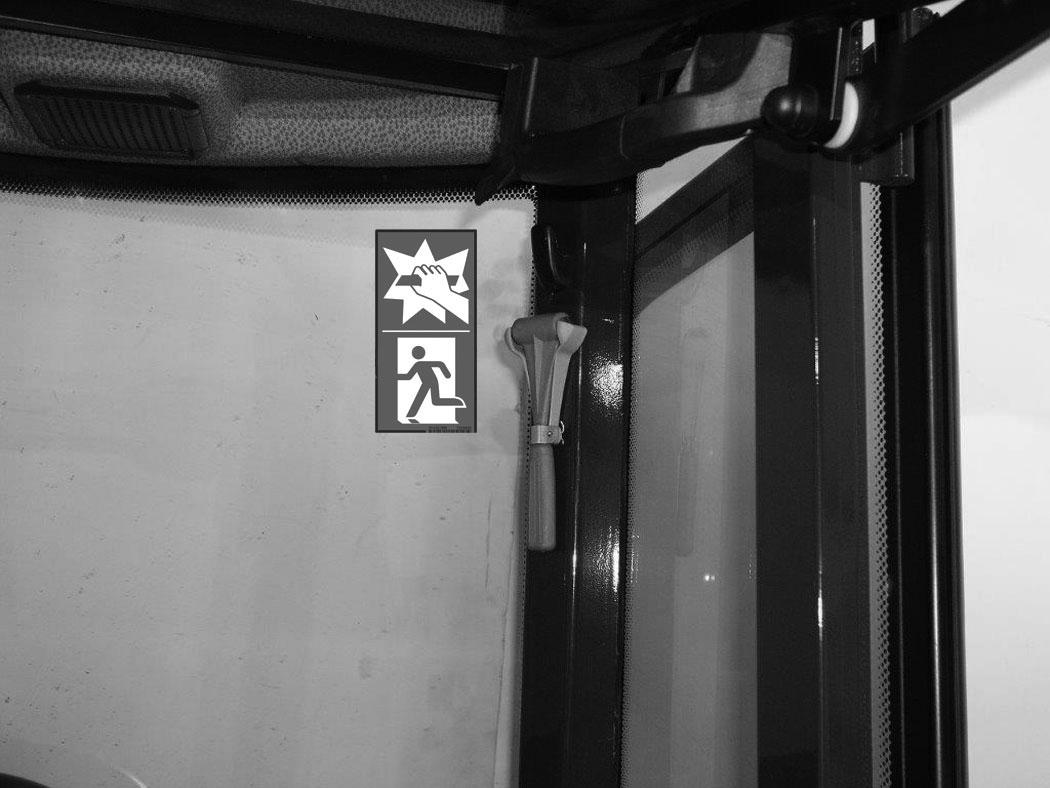
30
Remove the hammer from the storage position and strike the glass with the pointed end of the hammer [Figure 30]

Use the hammer (Item 1) [Figure 30] to remove broken glass from the edge of the window before exiting.

Front Window
Figure 31
Open the front window and exit [Figure 31]
NOTE:If the excavator has a Special Applications Kit installed, the front window is NOT an emergency exit.










